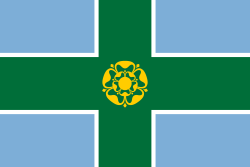History
The creation of the flag came about as a result of a feature on Andy Whittaker's breakfast show on BBC Radio Derby in 2006. [1] Jeremy Smith, a listener who had noticed the prominent use of Saint Piran's Flag while visiting Cornwall wanted to know whether Derbyshire had an equivalent symbol. As no flag to represent the county existed, a campaign to design one with the aid of listeners' suggestions was launched. [2] The finished flag, designed by Martin Enright from Derby, was unveiled on 22 September 2006. [3] Ceremonies to mark the first unfurling of the flag were held on the day at various locations around the county, including Derby, Ripley, Ashbourne and Buxton.
This page is based on this
Wikipedia article Text is available under the
CC BY-SA 4.0 license; additional terms may apply.
Images, videos and audio are available under their respective licenses.



